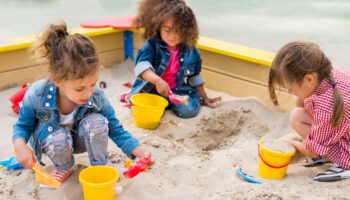Erin DelRegno
Play dough is a staple in a preschool classroom but I’m sure you also know how play dough can get dried out and crumbly in no time. Making homemade play dough is easy to do, includes many inexpensive ingredients you may already have at home, and lasts for a long time. Yes, play dough can make a mess on the tables and floor, but it is worth using and is one thing in your classroom that every child will enjoy.
There are also many benefits of playing with play dough:
- Fine Motor Skills – Manipulating play dough helps children strengthen muscles in their fingers and hands, which will prepare them for holding a pencil correctly, cutting with scissors, writing, and other tasks. This will also help to develop their hand-eye coordination.
- Stimulating Creativity – Play dough is an open-ended activity that allows children to use their imaginations, make whatever they want, and pretend. Remember that the process of the activity is more important than the end product. * Don’t forget to provide materials/toys for children to use as they create: cookie cutters, rollers, safe scissors, plastic cars, toy animals, utensils, combs, etc.
- Conversation and Building Vocabulary – Children will listen and talk with peers and you. They will ask each other for materials, talk about what they are making, and why. You can discuss how the play dough feels. You can add to this by emphasizing new words as children use the play dough (squish, pinch, roll, twist, squeeze, pound, knead, flatten, cut, etc.)
- Science and Math – Children will naturally use trial and error skills while using play dough and will create a variety of shapes. Many concepts can also be discussed: large/small, thick/thin, more/less, top/bottom, comparing sizes, etc. You can also add natural items for children to explore as they use the dough (feathers, pebbles, twigs, shells, pine cones, etc.). Just think of the prints, designs, and patterns they will make.
The following recipe will make enough play dough for multiple children to use at the same time:
Ingredients:
- 2 ½ cups flour
- 1 ¼ cup salt
- 2 tablespoons cream of tartar (you’ll find this in the spice section of the grocery store)
- 2 ½ cups water
- 5 tablespoons vegetable oil
- Food coloring
Steps:
- Mix the dry ingredients in a large pot.
- Add the water and oil.
- Mix the ingredients together (it will be lumpy). You can add the food coloring at this point if you want only one color of dough.
- Cook the dough over medium-low heat, stirring consistently.
- Continue stirring until the mixture is much thicker and begins to form a clump (this will happen in just a few minutes).
- Once the dough is not wet, remove from the stove and place dough onto a piece of wax paper.
- Knead the warm dough until it is smooth.
- If you want multiple colors of play dough, divide the dough, add some food coloring, and knead it into the dough. (If you don’t want to stain your hands with the food coloring, place the dough into a plastic sandwich bag and knead it while in there).
- Store in an airtight container or in a zip-lock bag.
* Important to Remember*
- While the ingredients used in this homemade play dough are safe, remember to teach the children that play dough is not for eating, and make sure to supervise them anytime they use it.
- Throughout the day in a classroom, the same play dough will be used by multiple children. Make sure children wash their hands before and after using play dough to prevent the spread of germs.
- If using play dough with children under 3 years of age, make sure that the toys and objects they use with the play dough are not too small, since young children tend to mouth materials and small toys could potentially be a choking hazard.
If you decide you want to make the play dough with the children in your classroom, this can be a great learning opportunity. Following the recipe will help children learn skills associated with counting, measuring, becoming familiar with print and why it is used, and following directions. You can also incorporate science into this activity by mixing primary colors to create new colors. Below is a link for a no-bake play dough to allow you to do this in the classroom, or at home with your own children, without having to use a stove:




